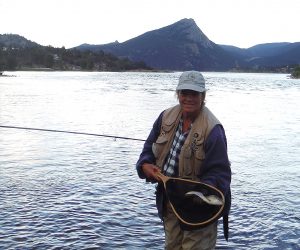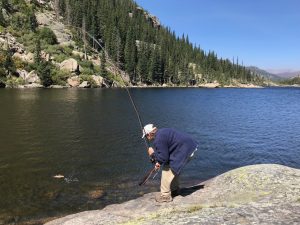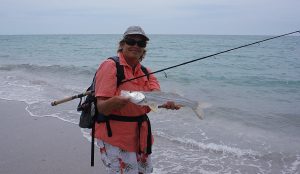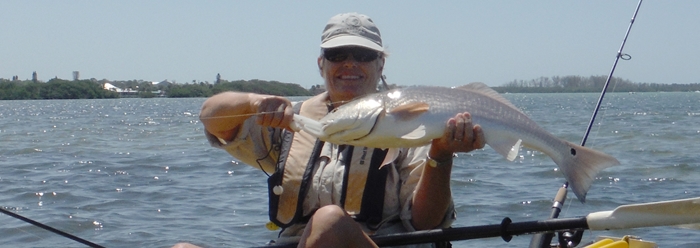Fishing blog: Tales of angling adventures from around the world
Welcome to our fish blog! Here you can read more sage advice from anglers around the world. This is the place for news, tips and non-fiction fish tales from mountain lakes to distant beaches. Please feel free to comment and join in on the conversations and share some fish tales of your own!
 Winter is on the run back up to the high country where snow drifts and ice still keep anglers at bay. This time of year the open water is right in town. Try the two inlets to Lake Estes right now. Two inlets? Yes, the Big Thompson enters Lake Estes near the 9-hole golf course but our favorite when water is high and muddy is the power plant outflow into the lake.
Winter is on the run back up to the high country where snow drifts and ice still keep anglers at bay. This time of year the open water is right in town. Try the two inlets to Lake Estes right now. Two inlets? Yes, the Big Thompson enters Lake Estes near the 9-hole golf course but our favorite when water is high and muddy is the power plant outflow into the lake.
The Big Thompson gets a lot of pressure below Lake Estes in the catch and release area upstream from Waltonia Road Bridge by Drake. Above the lake, the Big T flows through the 9-hole golf course. Here it flattens out later in the year to make for some great dry fly fishing. In the spring, the river can get high and muddy with the spring runoff.
The power plant outflow is warmer after traveling 13 miles under the continental divide from Grand Lake. The trip through the turbines aerates this water and makes it perfect for spawning rainbow trout in the spring. In the fall these same factors draw German brown trout to spawn here also.
We carry a lot of different flies and nymphs in our vests but a favorite the entire year is the “flying ant”. Whether it is recognized as an ant or a housefly by the trout matters not at all, they eat it gladly. Try one before sunset, you’ll like it.
Folks that appreciate the outdoors and wild things know that silence is golden. Hunters need to be stealthy to harvest game. How quiet depends on their choice of weapon. Bow hunters have to get closer than the guy with a scope. Kayak anglers can get close to feeding gamefish on shallow flats and tiny freshwater creeks. But that advantage disappears without stealth.
Stealth in a kayak starts with having a clear deck and a way to secure your rod and reel while positioning the kayak. Nothing puts a fish off like a reel falling onto the deck of a kayak; it sounds like a bomb going off underwater. Of course, a close second is banging the kayak with your paddle. Everybody can avoid making noise like this and one thing that helps is a damp towel on the deck where stuff usually falls. Our kayaks have a cup holder for a cold beverage, and we always use a foam insulating holder to quiet the can and keep it cool.
Paddling is another surefire way to spook fish. On a glass smooth shallow flat at sunrise, it can be a challenge to approach a feeding fish without making any sound. Paddles that bangs into an oyster bar or crunch a sandy spot sound the alarm underwater, so fish tend to stay a cast and a half away as you approach. There can be times when the water is too shallow to put the blade completely into the water. This gives you the choice of either “poling” or “splashing” with the paddle, either one creates a lot of commotion. In this situation, the best plan is an unadjusted drift that gets you into casting range or wading.
Even in deep water, noisy paddling can spook fish. The trick is to get the entire blade of the paddle in the water before taking a stroke. And don’t get too energetic even then. A powerful paddle stroke creates pressure waves and whirlpools you can see, and fish can feel. When lifting the paddle pause a moment while water drips off the blade close to the surface. Tiny stuff like this can make the difference between hooking a big smart fish or a little dumb one. If you adjust your position and need to put on the brakes when you get there, you used too much force. The commotion of stopping a kayak for a cast can put a feeding fish down.
So, you’re positioned for the perfect cast, but the target keeps moving away. It’s those darn pressure waves again. When kayaks rock side to side, waves are created as when paddling or casting. Learn to cast [fly or spinner] without rocking the boat. If you can see waves going out from the kayak, you’re telegraphing your location and size to the fish. Notice that hardly any pressure waves start at the bow and go forward so targeting fish ahead of the kayak lets you get closer. Stealth matters less on a choppy flat or windy lake than on a tiny, silent creek where nothing moves.
One thing that both boat anglers and kayak folks have to contend with is hull slap from waves. Flats boats feature hull designs minimizing slap. Kayaks can slap too, but it’s often avoidable with the proper load and profile. Our old Ocean Kayak Drifters™ are designed as super stable work horses that can carry450 lbs. Since neither of us is that heavy, our kayaks float higher than designed, making them susceptible to slap. Try to match the kayak to your normal load for minimal hull slap.
No one can fish from a kayak without making some noise. We hope these picky details will help kayak anglers of every skill level approach and catch more quality fish in quiet water. Just learn to be still and remember… stealth is not a color.
Anglers who spend the spring and summer in southwest Florida can enjoy some of the best fishing of the year if they get up early. During the warm and rainy season, folks down here can get “cabin fever” while confined in their air-conditioned home. There only one time when escape into cool air is possible and that’s early in the day. We have never been “O-Dark Thirty” anglers that naturally get up before dawn and head out. But, once we’re on the water with the sun coming up and the fish biting, we feel right at home. Our gulf beaches make an outstanding spot to visit as the sun rises.
Our favorite beach this time of year is Stump Pass Beach State Park in Englewood. Due to the limited parking available, early is the only time to go. There are a few parking spots along the “Ski Alley” side of the lot that lead directly to a break in the mangroves and a perfect launch. If we get there too late to luck into one of these spaces, a dolly helps with our heavy kayaks. Be aware that there are no spaces for trailers in this small lot.
Early also works with the tides right about now. Our favorite plan involves drifting down to the pass with the falling tide and fishing for snook. We can then float back to the launch on a rising tide. It isn’t always possible, but when it works it’s a lot of fun. The fishing in the pass and along the beach is worth getting up for.
If you choose to leave your kayak in the garage, it is fun to walk down to the pass from the parking area. The beach walk is only 1.1 miles to the pass but, the return trip can seem much longer. This is catch and release for snook these days but even when the season is open, any plan for getting a chilled fish back to the car requires some serious planning.
Early mornings usually start with an offshore breeze that knocks the waves down and helps with some long casts if necessary. Even the bugs ease up as the sun rises and they head back into the brush to escape the heat. Another factor that really helps is to have the sun over your shoulder which lets you see into the water better with polarized sunglasses. We usually find the water on the beach clearer than the warmer, algae colored bay water which makes sight fishing here exciting. You might not see snook, but their shadows give them away.
Most folks use spinning gear with either live shrimp or soft plastics for beach snook. We really enjoy the battle even a small snook provides on light [10 lb.] braid. Light line lets the fish deliver some long powerful runs without hanging up in nearby mangroves or dock pilings. Other anglers use fly rods with consistent success. An 8-wt. rod with a floating line will work most mornings. Remember, snook near the beach are feeding in the trough just a short distance from the dry sand. Be aware of your shadow this time of day as it will spook these snook. We usually cast either small shrimp flies or white clousers in the wash right along the shore. Determine which way the shore current is flowing so you can walk and fish “upstream” to approach these snook from their tail end. It always surprises us just how close we can get to these snook when we approach from downstream.
Should you choose to use live shrimp, leave the bait bucket in the car, and use a damp towel instead. Here’s how: soak a small towel in bait bucket water and wring it out. Then, put the shrimp on the towel and roll it up with the shrimp inside. You have to move quickly to keep the shrimp on the towel. Next, wrap the towel in an ice pack and put the whole package in a large zip closure bag. We use the plastic ice mats to keep our beach bags dry. The shrimp will be cold and slow when you get them out but will quickly become frisky as they warm up. This method is a lot lighter and easier to deal with than a bait bucket and air pump.
As the sun gets higher and the bite slows, we head back to the parking lot either by kayak or afoot to enjoy a late breakfast. Most days, we’re back home by 10 AM and ready for another day of work from home on our upcoming articles. We hope you get a chance to try this for a cool change of pace as the weather warms up.
As kayak anglers, we need terminal tackle that packs small and will draw strikes from any gamefish we expect to encounter. Jigs work well for us. They come in an endless variety of weights, colors and sizes, and feature many types of skirts ranging from deer hair to durable synthetic fibers and, our favorite, the plastic shad tail design. We almost hate to say it again, but we avoid multiple treble hook lures in the cozy confines of our kayaks. Even the remote chance that we could end up with a thrashing fish hooked on one hook of the treble and our leg hooked to the other treble justifies our reliance on single hook lures.
When Les was a kid growing up in Orlando, jigs were the only lure he carried in his tackle box. For that matter, they were the only lure he could afford on his allowance. They helped catch bass and bluegill from lakes within bicycling distance. Later, as he became more mobile, he found they also worked on shad in the St. Johns River, trolling them in the deep bends near Lemon Bluff. Jigs were also a favorite when he started fishing saltwater and landed snapper, lady fish, pompano, snook and mackerel from beaches on the east coast. On offshore trips, jigs brought grouper and amberjack as well as dolphin to the boat. In short, anything that eats live baitfish or even crustaceans will hit a jig…if the angler makes it look alive yet easy to catch.
Jigs were originally made with lead heads and some fibers attached to hide the hook and give it volume to slow the fall. These days, those jigs still catch fish, but plastic tails have taken over much of the market. Our favorites are the 3” plastic shad tails. Changing colors, designs, sizes or switching to scented or even live baits with a plastic tail is quick and easy compared to tying on a different hair jig for each change. Although colors like “electric chicken” catch fish, we usually try to “match the hatch” with more natural colors. A jig with a chartreuse or pink tip will attract strikes but it’s usually from baitfish, puffers or lizard fish that destroy the tail by biting off that colored tip.
Jig heads vary in design and color. Some styles have the eye positioned back on the head and capture weeds on the retrieve. Our favorite styles have the eye at the front, so weeds picked up by the line mostly slide off under the jig. The CAL jigs are an example of this type. CAL jigs also have glass eyes that gamefish key on during the strike. Weight varies but for the flats where we kayak, a 1/16th ounce or 1/8th ounce size seems to work best. Heavier jigs dig too deep when worked slowly and end up tangled in the grasses during slower retrieves. As for head color the “ancient wisdom” of red on the flats and white on the beaches works well, but Kimball likes chartreuse and out fishes Les regularly. Much heavier jigs are needed for targeting snook in deep channels around bridges or strong tidal currents.
The action of the jig is where the angler gets involved. There are different retrieves used by experienced anglers, but they are all variations of the “hop and drop” presentation that works in most situations. The object is to quickly lift the jig from the bottom and then let it settle back down before the next jerk. Gamefish see this rapid movement when you jerk the bait up from the bottom. It simulates a spooked baitfish. When the jig falls, it looks like an easy, disoriented meal and this is when most strikes occur. Just keep reeling to detect these subtle strikes. If the grass is thick on the flats, an alternate way to rig the jig tail is on a 2/0 wide gap hook with a bullet weight, the way bass anglers rig a worm. The main concept to keep in mind is that you need to move the jig slower when the water is cold. That is why we use 1/16th ounce jigs in the winter. Also, in the winter, a steady retrieve just above the grass on the bottom will draw strikes from lazy fish too cold to chase down anything frisky.
Keep in mind that speckled trout, redfish, and snook are “catch and release” only in our area to help them recover from last year’s devastating red tide event.
Kimball and Les Beery hiked to Mills Lake, Jewell Lake and Dream Lake in Rocky Mountain National Park recently to catch a few trout and see how the brook and rainbow trout populations are sorting out the Mills Lake habitat. Back in the day, the rainbows held the lake, and the brookies were mostly found in the inlet above Jewell Lake. Now, they’ve become more integrated with rainbows above Jewell Lake and some brook trout down in Mills. These were fine days for a hike and some fishing before the snow arrives in the high country. 







